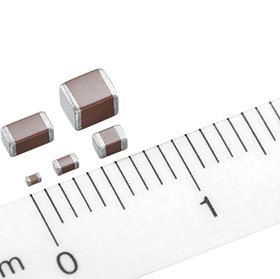Automotive-grade MLCCs
22 February 2017
Passive Components

TDK has expanded its CGA series of automotive-grade multilayer ceramic chip capacitors (MLCCs) for high-temperature applications. New MLCCs with X8L temperature characteristics have been introduced and the capacitance range of its existing X8R types has been extended. With the new types, TDK’s lineup of X8L and X8R MLCCs features an unrivalled high capacitance range of up to 22 μF. These capacitors offer high reliability at temperatures from -55°C to +150°C, with a capacitance drift of just ±15% for the X8R types and +15%/-40% for the X8L types.
Increasingly automotive electronic control units are being located in the engine compartments or near other structural parts, where the electronic components must be able to withstand high temperatures and offer high reliability and performance. The new high-temperature MLCCs were made possible by the development of a new dielectric material that maintains excellent reliability, even in extreme environments. To further improve reliability, the X8R dielectric material is now also available for soft-termination and conductive epoxy MLCCs, which help to prevent board flexure cracks and solder cracks caused by thermal stress.
Thanks to their temperature characteristics and high capacitance values, the new AEC-Q200 qualified MLCCs are suited for applications in high temperature environments such as engine compartments or in close proximity to transmission oil tanks. They also offer outstanding performance in smoothing and decoupling circuits of switch-mode power supplies for industrial equipment.
For more information contact Pieter Engelbrecht, Avnet South Africa, +27 (0)11 319 8600, [email protected], www.avnet.co.za
Further reading:
Vibration-resistant axial capacitors
RS South Africa
Passive Components
TDK Corporation has unveiled the B41699 and B41799 series of ultra-compact aluminium electrolytic capacitors, engineered to withstand operating temperatures of up to 140°C.
Read more...
Capacitors for demanding industrial applications
Passive Components
TDK Corporation has announced its X1 capacitors of the EPCOS B3291xH/J4 series for power line filtering of electromagnetic interferences in demanding automotive and industrial applications with a rated AC voltage of up to 480 V.
Read more...
Wide frequency range inductors
RS South Africa
Passive Components
TDK Corporation has expanded its ADL4524VL series
(4,5 x 2,4 x 2,6 mm – L x W x H) of wire-wound inductors for automotive power-over-coax.
Read more...
Cutting-edge hybrid capacitors
Avnet Silica
Passive Components
Panasonic Industry recently announced the launch of the ZVU Series Hybrid Capacitors, a cutting-edge solution tailored to meet the escalating demands of advanced electronic systems.
Read more...
Low-profile tantalum chip capacitors
Electrocomp
Passive Components
These general-purpose tantalum capacitors from Kyocera AVX are available in multiple case sizes with low profile options.
Read more...
Coupled inductor for high-performance applications
Passive Components
This coil with MnZn core is characterised by its high permeability and extremely low RDC values, which achieves excellent power density and very high efficiency.
Read more...
Power inductors
iCorp Technologies
Passive Components
he HTF-MP series is more suitable for complex multiphase power supply applications in design, effectively meeting the needs of ultra-thin and high-power devices.
Read more...
SMT power inductors
Future Electronics
Passive Components
The Würth Elektronik WE-MXGI SMT power inductors are the latest addition to Würth Elektronik’s moulded power inductor series, engineered for high-frequency power applications.
Read more...
Large capacitance MLCCs at 100 V
RS South Africa
Passive Components
TDK Corporation has expanded its CGA series for automotive multilayer ceramic capacitors to 10 µF at 100 V in 3225 size.
Read more...
Film and mica capacitors
Actum
Passive Components
By utilising various polymer dielectrics plastics, Exxelia film and mica capacitors meet most technical requirements and serve all functions from standard filtering to specialised applications.
Read more...


